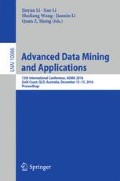Abstract
Effective methods for identification of software defects help minimize the business costs of software development. Classification methods can be used to perform software defect prediction. When cost-sensitive methods are used, the predictions are optimized for business cost. The data sets used as input for these methods typically suffer from the class imbalance problem. That is, there are many more defect-free code examples than defective code examples to learn from. This negatively impacts the classifier’s ability to correctly predict defective code examples. Cost-sensitive classification can also be used to mitigate the affects of the class imbalance problem by setting the costs to reflect the level of imbalance in the training data set. Through an experimental process, we have developed a method for combining these two different types of costs. We demonstrate that by using our proposed approach, we can produce more cost effective predictions than several recent cost-sensitive methods used for software defect prediction. Furthermore, we examine the software defect prediction models built by our method and present the discovered insights.
Access this chapter
Tax calculation will be finalised at checkout
Purchases are for personal use only
References
Nasa-software defect datasets. http://openscience.us/repo/defect/mccabehalstedl. Accessed 24 July 2016
Bunkhumpornpat, C., Sinapiromsaran, K., Lursinsap, C.: Dbsmote: density-based synthetic minority over-sampling technique. Appl. Intell. 36(3), 664–684 (2012)
Chawla, N.V., Bowyer, K.W., Hall, L.O., Kegelmeyer, W.P.: Smote: synthetic minority over-sampling technique. J. Artif. Intell. Res. 16, 321–357 (2002)
Domingos, P.: Metacost: A general method for making classifiers cost-sensitive. In: Proceedings of the fifth ACM SIGKDD International Conference on Knowledge Discovery and Data Mining, pp. 155–164. ACM (1999)
Halstead, M.H.: Elements of software science. North-Holland (1977)
He, H., Bai, Y., Garcia, E.A., Li, S.: Adasyn: adaptive synthetic sampling approach for imbalanced learning. In: 2008 IEEE International Joint Conference on Neural Networks (IEEE World Congress on Computational Intelligence), pp. 1322–1328. IEEE (2008)
Islam, M.Z.: EXPLORE: a novel decision tree classification algorithm. In: MacKinnon, L.M. (ed.) BNCOD 2010. LNCS, vol. 6121, pp. 55–71. Springer, Heidelberg (2012). doi:10.1007/978-3-642-25704-9_7
Islam, Z., Giggins, H.: Knowledge discovery through sysfor: a systematically developed forest of multiple decision trees. In: Proceedings of the Ninth Australasian Data Mining Conference, vol. 121, pp. 195–204. Australian Computer Society, Inc. (2011)
Jiang, T., Tan, L., Kim, S.: Personalized defect prediction. In: 2013 IEEE/ACM 28th International Conference on Automated Software Engineering (ASE), pp. 279–289. IEEE (2013)
Ling, C.X., Sheng, V.S., Bruckhaus, T., Madhavji, N.H.: Maximum profit mining and its application in software development. In: Proceedings of the 12th ACM SIGKDD International Conference on Knowledge Discovery and Data Mining, pp. 929–934. ACM (2006)
McCabe, T.J.: A complexity measure. IEEE Trans. Softw. Eng. 4, 308–320 (1976)
Öztürk, M.M., Cavusoglu, U., Zengin, A.: A novel defect prediction method for web pages using k-means++. Expert Syst. Appl. 42(19), 6496–6506 (2015)
Quinlan, J.R.: C4. 5: programs for machine learning. Elsevier (2014)
Ramentol, E., Caballero, Y., Bello, R., Herrera, F.: Smote-rsb*: a hybrid preprocessing approach based on oversampling and undersampling for high imbalanced data-sets using smote and rough sets theory. Knowl. Inf. Syst. 33(2), 245–265 (2012)
Ricky, M.Y., Purnomo, F., Yulianto, B.: Mobile application software defect prediction. In: 2016 IEEE Symposium on Service-Oriented System Engineering (SOSE), pp. 307–313. IEEE (2016)
Sheng, V.S., Gu, B., Fang, W., Wu, J.: Cost-sensitive learning for defect escalation. Knowl. Based Syst. 66, 146–155 (2014)
Shepperd, M., Song, Q., Sun, Z., Mair, C.: Data quality: some comments on the nasa software defect datasets. IEEE Trans. Softw. Eng. 39(9), 1208–1215 (2013)
Siers, M.J., Islam, M.Z.: Cost sensitive decision forest and voting for software defect prediction. In: Pham, D.-N., Park, S.-B. (eds.) PRICAI 2014. LNCS (LNAI), vol. 8862, pp. 929–936. Springer, Heidelberg (2014). doi:10.1007/978-3-319-13560-1_80
Siers, M.J., Islam, M.Z.: Software defect prediction using a cost sensitive decision forest and voting, and a potential solution to the class imbalance problem. Inf. Syst. 51, 62–71 (2015)
Siers, M.J., Islam, M.Z.: Standoff-balancing: a novel class imbalance treatment method inspired by military strategy. In: Pfahringer, B., Renz, J. (eds.) AI 2015. LNCS (LNAI), vol. 9457, pp. 517–525. Springer, Heidelberg (2015). doi:10.1007/978-3-319-26350-2_46
Siers, M.J., Islam, M.Z.: Rbclust: High quality class-specific clustering using rule-based classification. In: European Symposium on Artificial Neural Networks, ESANN 2016 (2016, Accepted)
Tahir, M.A., Kittler, J., Yan, F.: Inverse random under sampling for class imbalance problem and its application to multi-label classification. Pattern Recogn. 45(10), 3738–3750 (2012)
Author information
Authors and Affiliations
Corresponding author
Editor information
Editors and Affiliations
Rights and permissions
Copyright information
© 2016 Springer International Publishing AG
About this paper
Cite this paper
Siers, M.J., Islam, M.Z. (2016). Addressing Class Imbalance and Cost Sensitivity in Software Defect Prediction by Combining Domain Costs and Balancing Costs. In: Li, J., Li, X., Wang, S., Li, J., Sheng, Q. (eds) Advanced Data Mining and Applications. ADMA 2016. Lecture Notes in Computer Science(), vol 10086. Springer, Cham. https://doi.org/10.1007/978-3-319-49586-6_11
Download citation
DOI: https://doi.org/10.1007/978-3-319-49586-6_11
Published:
Publisher Name: Springer, Cham
Print ISBN: 978-3-319-49585-9
Online ISBN: 978-3-319-49586-6
eBook Packages: Computer ScienceComputer Science (R0)

